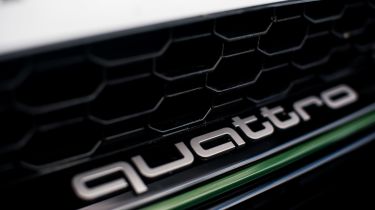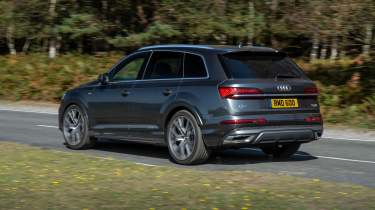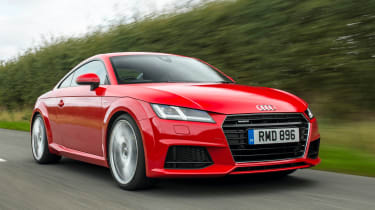What is Audi quattro all-wheel drive?
We explain everything you need to know about the Audi quattro all-wheel drive system

Many modern cars feature four-wheel drive, but the Audi ‘quattro’ system was one of the first to reach the mass-market. The German marque initially developed the technology for motorsport during the 1980s, but over time it filtered through to its road cars. Now the system is offered on almost all of the brand’s cars, after the benefits of four-wheel drive were proven useful and desirable for all kinds of road cars, including hatchbacks, saloons, estates and SUVs.
The ‘quattro’ trademark is spelled with a lowercase ‘q’ in line with Audi’s branding on the original Audi quattro sports car. Today, the brand’s highest performance cars, such as its RS-badged models, are fitted with it as standard, and even its electric models such as the e-tron GT saloon and Q4 e-tron SUV are equipped with a new form of its quattro system.
 BMW xDrive explained: what is it, issues, and is it worth it?
BMW xDrive explained: what is it, issues, and is it worth it?
But how does it work and, more importantly, do you need it? In this guide, we’ll explain everything you need to know about Audi’s quattro all-wheel drive, and help you decide whether it’s worth spending the money on.
We also have guides to DSG automatic gearboxes and Audi’s Virtual Cockpit, both of which are worth knowing about before purchasing an Audi.
What does Audi quattro do?
Audi quattro is a four-wheel drive system – ‘quattro’ meaning ‘four’ in Italian. But what does ‘four-wheel drive’ actually mean?
In a ‘normal’ two-wheel drive car, all the power produced by the engine is sent to either the front or rear wheels – depending on whether it’s front or rear-wheel drive. In a four-wheel drive car – including Audis fitted with quattro – power is distributed between all four tyres. Because each individual wheel is powered, a car with four-wheel drive has more traction when accelerating than a two-wheel drive car.

This provides major safety benefits in damp or slippery conditions. Where a two-wheel drive car may struggle for traction, potentially spinning its wheels, a four-wheel drive car is more likely to find grip and accelerate without issue. This is particularly noticeable when cornering tightly – think navigating a roundabout – or when accelerating out of a corner.
Many Audi owners choose a model with quattro four-wheel drive if they live in the countryside where roads are often muddy, or for commuting in remote or higher altitude parts of the country where snow and icy conditions are more common.
The same principle of maximising traction applies to quattro performance models, which are capable of faster acceleration and cornering thanks to the additional grip that comes from having all four wheels driven.

We should also mention quattro SUVs and off-roaders, as Audi also offers Q3, Q5 and Q7 SUVs with quattro. Again the advantage is extra traction, essential for anyone venturing off-road onto mud or gravel trails. This is also why quattro comes into its own when towing, as you’re less likely to lose traction.
How does the Audi quattro system work?
There are three basic types of quattro setup that Audi uses in its combustion-engined cars and they have slightly different characteristics, although most drivers are unlikely to be able to feel a difference in practice.
The system fitted to the A4, A6 and Q8 is most common, and here the quattro setup has a default engine power split that’s biased 60% to the rear wheels and 40% to the front wheels. It’s designed to give you the feeling of driving a rear-wheel drive car in normal use but, if the rear-wheels begin to lose traction, the system can instantaneously divert more power to the front wheels.
Smaller models such as the quattro A3 and the TT quattro – which share their platform with the Volkswagen Golf – have a set-up that reverses the bias. Here, the quattro system powers the front wheels almost exclusively until they start to lose grip, at which point the car’s computer decides to divert some power to the rear wheels – but they never get more than 50% of it.

The Audi R8 quattro boasts supercar performance and the four-wheel-drive system sends 85% of its engine power to the rear wheels during normal driving conditions, again diverting power instantly to the front wheels when required to prevent a loss of traction at the rear wheels.
Do electric Audis have quattro?
Audi’s range of ‘e-tron’ electric cars are available with quattro, too, although the system works differently to that in its petrol and diesel cars.
Electric cars don’t transmit their power to the wheels like a typical combustion-engined car – in fact, they don’t use a traditional gearbox at all. Instead, an electric motor is located between either the front wheels, rear wheels, or both in the case of a four-wheel drive electric car. Electric Audi e-tron models with quattro use one motor for the front wheels and another motor for the rear, and the car’s computer decides how much power each motor outputs.

From behind the wheel, you get the same four-wheel drive benefits as a combustion-engined car with quattro. That means better traction when cornering and in slippery conditions compared to a rear-wheel drive or front-wheel drive car.
Is quattro worth having?
Whether you really need quattro or not depends on your style of driving and the types of road conditions you’re faced with; the majority of Audis without quattro aren’t renowned for crashing on wet roundabouts, after all. However, if you live in an area prone to slippery conditions, then quattro will probably be of benefit to you.
It’s also worth remembering that tyre condition and specification are potentially more significant factors to consider when it comes to grip and traction. Choosing to invest in a set of winter tyres for snowy and icy conditions, for example, is likely to bring greater benefits than quattro alone.
The price difference between quattro all-wheel drive and rear-drive models is significant but not excessive. If you’re considering it on a new Audi purchase, don’t forget you’ll likely benefit from a higher residual value when you choose to sell the car on – used quattro models are in demand too, with prices remaining strong for older cars.
Before opting for quattro, consider whether the extra cost and marginal fuel consumption increase, due to extra weight, is worth it for the advanced handling benefits.
Frequently Asked Questions
Do you want to know more about the Audi model range? Read our in-depth reviews of the Audi A3 sportback, the Audi e-tron GT saloon and the Audi Q7 SUV.
Most Popular
Tips & advice

Car dashboard warning lights: what does each symbol mean?

Electric car charging stations: public networks, charger types, apps and maps






